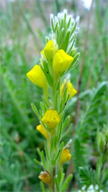 The San Bernardino Mountains Indian paintbrush, or Castilleja lasiorhyncha, is a species of Indian paintbrush endemic to southern California. It is sometimes referred to as San Bernardino Mountains owl’s-clover. Most of the plant’s range is in the San Bernardino Mountains, where it grows in forests and meadows. Its presence has been noted at Moonridge, Big Bear Lake, Forest Falls, Keller Peak, Strawberry Canyon, Bluff Lake Meadow, Harrison Mountain, San Bernardino North, Fawnskin, Big Bear City, Lake Arrowhead, Butler Peak and Silverwood Lake.
The San Bernardino Mountains Indian paintbrush, or Castilleja lasiorhyncha, is a species of Indian paintbrush endemic to southern California. It is sometimes referred to as San Bernardino Mountains owl’s-clover. Most of the plant’s range is in the San Bernardino Mountains, where it grows in forests and meadows. Its presence has been noted at Moonridge, Big Bear Lake, Forest Falls, Keller Peak, Strawberry Canyon, Bluff Lake Meadow, Harrison Mountain, San Bernardino North, Fawnskin, Big Bear City, Lake Arrowhead, Butler Peak and Silverwood Lake.
Castilleja lasiorhyncha’s only currently existing populations are in San Bernardino County and possibly San Diego County, with historical occurrences also known from Riverside County. It is threatened by development, mining, non-native plants, water diversions, grazing, fire suppression, vehicles, and recreational activities.
This wildflower is an annual herb usually not exceeding nine inches in height. Its stem and foliage are coated in woolly glandular hairs. The inflorescence is a loose, narrow array of green bracts and larger flowers, each with rounded, pouched bright yellow petals and a hairy whitish beak.
Generally within the genus of Castilleja, commonly known as Indian paintbrush or prairie-fire, there are about 200 species. These annual and perennial herbaceous plants are spread beyond San Bernardino County and are native to the west of the Americas from Alaska south to the Andes, and northern Asia. There is one species as far west as the Kola Peninsula in northwestern Russia. These plants are classified in the broomrape family, Orobanchaceae, following major rearrangements of the order Lamiales starting around 2001. Out of date sources which do not follow or predate these reclassifications may place them in the Scrophulariaceae. They are hemiparasitic on the roots of grasses and forbs. The generic name honors Spanish botanist Domingo Castillejo.
Castilleja species are eaten by the larvae of some lepidopteran species, that is butterflies and moths, including Schinia cupes and Schinia pulchripennis, and checkerspot butterflies, such as Euphydryas species.
The flowers of Indian paintbrush are edible, and were consumed in moderation by various Native American tribes as a condiment with other fresh greens. These plants have a tendency to absorb and concentrate selenium in their tissues from the soils in which they grow, and can be potentially very toxic if the roots or green parts of the plant are consumed. Highly alkaline soils increase the selenium levels in the plants. Indian paintbrush has similar health benefits to consuming garlic if only the flowers are eaten in small amounts and in moderation.
While selenium deficiency is far more common in humans than selenium toxicity, getting too much selenium can happen. A tell-tale sign of selenium poisoning is that those suffering from it begin to crave selenium-containing foods, which can result in morbid toxicity.
The Ojibwe used a hairwash made from Indian paintbrush to make their hair glossy and full bodied, and as a treatment for rheumatism. The high selenium content of this plant has been cited as the reason for its effectiveness for these purposes. Nevada Indian tribes used the plant to treat sexually transmitted diseases and to enhance the immune system.
From Wikipedia, http://www.rareplants.cnps.org/ and www.calflora.net
SBCSentinel
News of note from around the largest county in the lower 48 states.
